Trending
Opinion: How will Project 2025 impact game developers?
The Heritage Foundation's manifesto for the possible next administration could do great harm to many, including large portions of the game development community.

Featured Blog | This community-written post highlights the best of what the game industry has to offer. Read more like it on the Game Developer Blogs or learn how to Submit Your Own Blog Post
This blog post is about the experiences of a Turkish game developer, Arda Cevik at Nordic Game Jam 2015.

[This blog post was first published at Gram Games blog page]
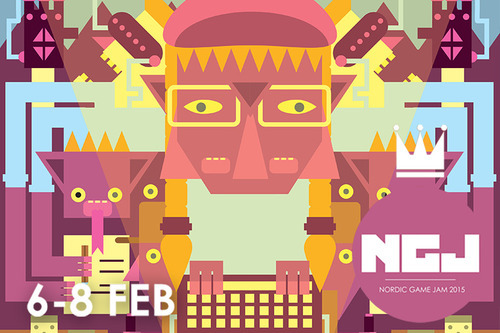
This is Arda Cevik, a game designer & developer located in Istanbul, Turkey. I work at Gram Games as a software developer, and we are developing a sequel title for our hit game 1010!. I'm pursuing a Master's Degree in Game Design at Bahcesehir University. And in my free time, I participate game jams abroad.
Last week, we were at a game jam in Copenhagen with an indie developer from Istanbul, Talha Kaya. Nordic Game Jam, the inspiration behind Global Game Jam, takes place in Copenhagen - Denmark every year since 2006. This year there were 731 attendees. It was named the biggest game jam in the world even last year, with 500+ attendees.
In this post, I will talk about how I managed to survive the biggest game jam in the world.
We started our journey on the 5th of February, Thursday by getting in our plane from Istanbul. After a pleasant journey with THY we landed in Copenhagen. Kemal Akay greeted us at the airport and took us to the student dormitory of the IT University of Copenhagen. We missed the pre-jam party “All The Rave” since we arrived late at night and decided to sleep and save our energy for the next day. I regret missing the party, as I would be happy to see the live performance of Little Nando and experience a party concept that combined rave & game scene. And the worst was missing the free beers that IO Interactive gave away.
On friday, we took a little trip to the city center and then went to Aalborg University where the jam took place. These are what I want to tell about the city:
The symbol of the city is super cute, reminds me of the logo of Walt Disney. It is like a fairy tale with its curly towers.
I was expecting about -10 C degrees since it is the most northern country I have ever visited and its February. Fortunately, the weather was warmer than I expected.
Copenhagen is a small city. It is quite cozy around Neuhavn. Metro line is short and it is easy to get around. Christiania is a crazy place.
There are no drivers in the metro trains, they are controlled by the artificial intelligence. When we first got on, we felt like Gordon Freeman arriving at Black Mesa.

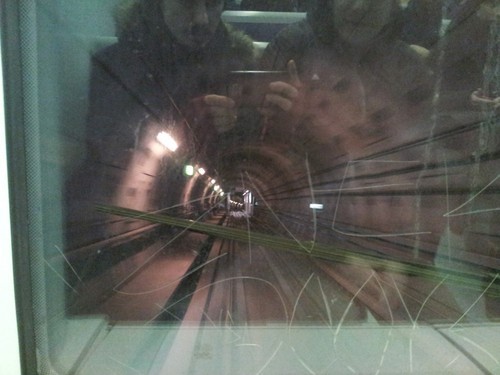
When we arrived at the university, the seminars were not started yet, and we explored the place a bit. We saw how fine a public university in Denmark could be. There were two seperate buildings and an extension of the sea between them, and a bridge connecting two buildings. It feels like a 5 star hotel near the seaside while looking through the windows.

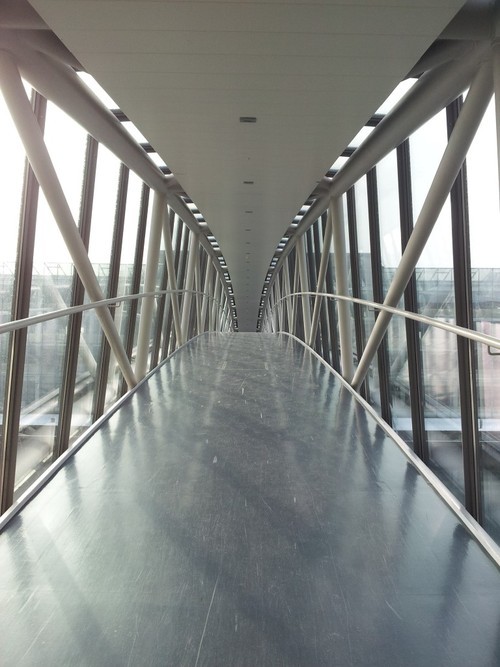
We were told that the jam would start at 9pm, so we attended some talks. Here are some keypoints from the talks:
Little Nando
Little Nando was live at the party we missed the previous night. He is an Argentinian VJ, a game developer and a game master.
Little Nando controls the game with a keyboard on the stage. Two players get on the stage and play against the game that Little Nando controls. There is dubstep music playing on the background. Little Nando spawns the enemies and bosses in the game and the players fight against these enemies.
I would like to see such games at parties. It promises an entertaining and extraordinary experience.
John Almbecker - Kim Krogh, King.com
John and Kim talked about how prototyping-based production process works and how they developed Candy Crush Soda.
There is a fast and efficient process of production at King. They really care about prototyping.
The success of Candy Crush Soda is primarily based on the retention values (the percentage of the players who are returning to the game), and secondarily on the conversion rates (the ratio of the players who pay for the game among the other players). The important thing for King is not to develop a game for gamers with money, but to make the game available for as many people as possible.
Sos Sosowski
The presentation of the Polish indie developer Sosowski was colourful. He gave a talk about how we can easily produce entertaining music.
The beats and melody, which he created in just 5 minutes, was more than enough for a jam game.
Sosowski’s dance is so cute.
James Portnow - Extra Credits
After leaving Sosowski’s presentation, I went to listen to James’ talk. I bumped into a totally different atmosphere. James is good at making impressive presentations, with his epic expression and inspiring music.
Together we asked the questions; ”Why are we developing games?”, ”What are the effects of our games?”, ”Are games effective for education?”
James’ actual voice is not like a cartoon character.
Stewe Swink - Game Feel
Stewe is the writer of the book ”Game Feel” which is popular among game designers.
He talked about how we can develop games that meet the expectations and difficulties of game development.
When the talks were over, we gathered at the big hall. Organizers talked about how NGJ was started, what they had done in the past years, and how crowded we were now. They also mentioned that they were going to provide devices like Oculus VR, Tobii EyeX, holographic display systems upon request.
And then, this year’s theme was announced:
Obvious
After the announcement of the theme, the organizers suggested some points about forming groups. There were circles on the floor that could hold up to almost 10 people in it, formed by colorful tapes. They said that there were such group forming spots on several floors and all of them had those circles. If you want to join a group, you enter that group's circle. It is mandatory to speak with the people in that circle. When one of the organizers blows the horn in his hand, you can leave your circle and enter another one. If you think you are done forming the group, you sit altogether and wait for an organizer to lead you to your working space.
When we registered at the entrance, we wore one of the colorful wriststraps; blue, purple, red or green. They directed us to the floors relevant to our wriststrap color. I entered a circle immediately, and started talking with the other people in the circle. After some time to chat, we decided to sit down before the number of our group members increased. We were already 10+ people. 3 Italian programmers decided to leave (and we already had 3 programmers) and joined another group. Our final group consisted of 7 people and we went to our working space. Before the jam started, they had announced that some groups might ask for the eye tracker device. Each and every member in our group was excited about that device. We all agreed on using the technology provided by the eye tracker device and implement an idea that has never experimented before, and we got our Tobii EyeX device.
Back at the University, I participated in a study using an eye tracker. With glasses (without a lens) and two micro cameras close to the eyes, the movement of the eyeballs could be detected efficiently and transferred to digital media. With the calibration of the screen and the eyes’ position, the area that your eyes are focused on the screen could be detected. Tobii improved the concept of this eye tracking device that was worn like glasses, and created a thin device that you put in front of your screen, like Kinect. The Tobii EyeX device is quite successful. It can accurately detect your gaze position on the screen after a short calibration process. It is also quite easy to integrate the device into your game thanks to the Unity3D SDK provided. I missed the Tobii presentation, but I heard they talked about that they’re working with Steelseries and they’re getting involved in e-sports, and there are some upcoming titles like Assassin’s Creed Rogue that uses these eye tracker devices. Tobii made a great move by bringing the eye tracker devices to a game jam like NGJ, where lots of skillful developers and designers come together and crave for making innovative, creative and experimental games.
We went to our working space and provided a white board. We wrote down our ideas evolving around the eye tracker. These were the main ideas we came up with:
Detecting the odd-one-out object among multiple objects, players as thief - police roles, asnychronous gameplay, party games, deception, blending in
We were close to finding an idea. First concepts started to emerge:
2+ players controlling the pieces of a robot, moving asynchronously (with controllers). An observer tries to spot a robot blended in, among the AI controlled human characters using the eye tracker.
A player as the thief, and the other as the police. The thief tries to hide from the police’s gaze, and manipulates the environment to distract the observer.
Then our friend mentioned about the game “Red Light - Green Light” that he used to play as a child. I think we have a similar version of this game in our culture. In Red Light - Green Light, the players need to stand still when the observer’s eyes are open. When the observer closes her eyes, other players run to the observer. If any player is moving when the observer opens her eyes and is spotted, that player moves back to the starting point as a penalty. We agreed on building our idea around this game:
There are 1-4 players with controllers and 1 player with the eye tracker. There are 10 boom boxes (loudspeakers in fact) in the scene, and except the ones that are controlled by the players, are controlled by the AI. When the player using the eye tracker closes her eyes, the boom boxes run towards her. When the observer opens her eyes, boom boxes stop and adapt to the music playing in the background, and make the squishy dance moves according to the beat. Players with the controllers need to adapt to the beat in order to not being noticed by the observer. The observer reloads the bullet while keeping her eyes closed, and needs to shoot the obvious boom box until it comes near her. If any one of the players with the controllers comes too close to the observer, the players win. If the observer manages to shoot all the players, the observer wins.

After we decided on what to do, we got to work. In our team, we had a level designer (Chris) who works at Ubisoft, on the Rayman Origins and Rayman Legends titles, a Danish student (Sandra), also a Danish student (Gustav), a French student that studies in Malmö (Maxime), a Polish developer (Matthew), a Turkish guy (me) and Erik. Erik, who had the idea of Red Light - Green Light was sick for the rest of the jam, and couldn’t make it for the next days.
For the first night, we prioritized our tasks and separated the tasks among the group members. Matthew, Gustav and my task was to make the prototype work, and achieve a testable build to experience the gameplay until the next morning. I took on the development with the eye tracker. On the first night, I installed the SDKs, and made some small tests. We were sure that we could use the eye tracker device’s features as we expected, and caught some sleep until the next morning.
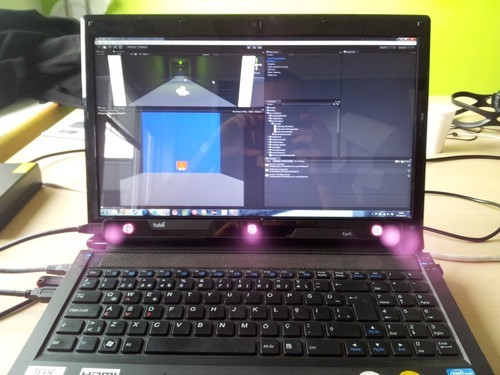
We went back to the jam site next morning. We decided to check what was going on around the site, and continued working afterwards. After breakfast, it was quite calm around the place. There were some groups working on board games in the common hall, and they were using physical prototyping materials.

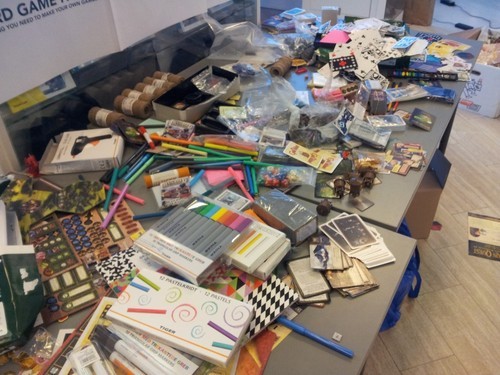
We had a rough prototype ready in the afternoon. Music was playing, players with controllers were moving, the eye tracker was detecting the gaze position of the observer, and shooting mechanics (close eyes, open eyes and shoot where you’re pointing at) were working. We had a glimpse of what the actual game might look like, and we were satisfied with the results. The game was actually fun to play in the prototype stage. We could also see what issues we could run into, find the questions we needed to ask and problems we needed to solve as we had the working prototype (how can the players keep up with the beat, how fast should they run, how long should the game sessions be, etc). Through the day, we continued developing and iterating, and tested each phase. We also tested the game with other players, and received positive feedback. We made sure that we were going in the right direction, so we kept on developing.
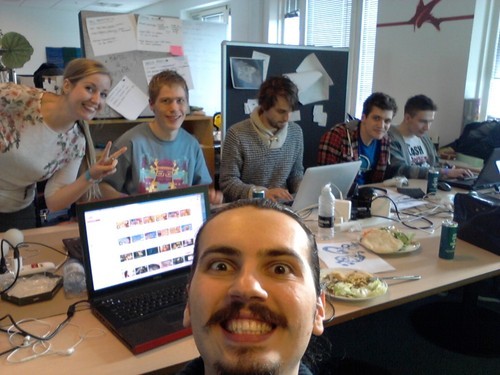
A placeholder music was playing in the background for the first iterations. We used the “Epic sax guy” music in a loop. Each time we launched the game we were listening to this catchy music, and eventually ended up humming the melody. We even thought about using this song as our actual music. Also, we named our team the “Epic Sax Team”.
On the previous jams I’ve attended, we almost always left the audio to the very end. It’s the fate of games delivered at the last moment, to have the audio missing. This time we used placeholder music, gun sounds, and walking sounds (that are at the core of the gameplay) from the beginning. The advantage was this: In each iteration, we could imagine how the gameplay should be at the end, and we could stay with the same mind as we heard the sound effects.
When the time came to produce our own sounds, we realized that we lacked software and hardware to produce audio. Then Figure app came to our help. I remembered that in an episode of Super Game Jam, a developer suggested using Figure to produce easy and quality music. I gave my iPad and headphones to Maxime. He made 5 high quality loop songs in a very short time. I would highly recommend using Figure to produce good quality music for your game.
Here are the songs we made for our game:
We kept on working and taking short breaks until morning in order to deliver the game until the deadline. Our core mechanic was working, we were getting good feedback from the testers, and it seemed that players were actually having fun. We had to solve some problems, and work on the aesthetics more. As we Turks say, “You’re screwed-blue” (Sıçtın mavisi) was approaching on the sky. (When you overnight, and need to deliver something in the morning, you see the first sun beams coloring the sky in a particular tone of blue)
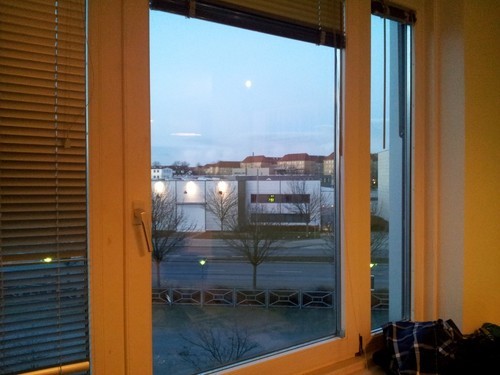
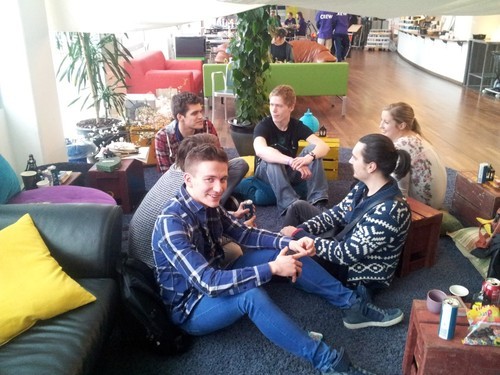
When we were getting close to the deadline, we fixed the major problems and had a playable build. There were some features missing, though. We focused on the implementation of the must-have features and assets at first. We couldn’t implement the tutorial, changing of the beat on the music change, disco ball assets and some other details. Our mistake was that we couldn’t keep developing and sustaining the same development environment on the other computers. We could achieve a better result if we could integrate the assets on the other computers and keep the work flowing, though. We mostly focused on fixing bugs and this created a bottleneck on the development process, so that’s why we could not use the assets we prepared on the other computers.
At the end of the day, we had an enjoyable game and a huge jam’s exhaustion. We waited for the presentations, and accompanied by great Polish beer. "Polish Invasion" was happening, a full bus of Polish game developers brought lots of beer with them.
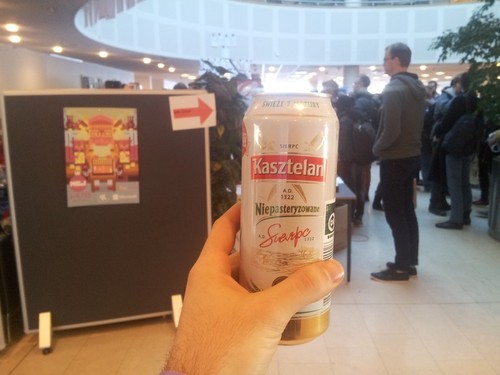
The first game jam I’ve attended was in Ankara, Turkey in 2011. That jam was like a competition, and some groups were in the competitive mindset. Nordic Game Jam also follows the format of competitions. There are winners, and prizes. Games get voted in groups, finalists are elected, then the community votes for the finalists and the jury decides on which game is the best. At my first game jam in Ankara, there were big prizes like mobile phones, monitors, games, etc. This probably has brought the participants in a more serious and ambitious environment. Some were focused on the competition, detracting from the experience of game jams, missing the core features like socializing, helping each other and being experimental. In NGJ, probably because the prizes were symbolic, this tense environment didn’t form. I experienced a game jam away from stress and competition.

Our game was in a group of 14-15 games. We needed to get the most votes at the end of presentations, to get to the finals. Then we made our presentation, and watched other games’ presentations. We had 11 votes at the end, and the game “Look at my drawing” had 12, so they made it to the finals. I will write another blog post about the other games soon. You can check all the submissions in this link by the way.
And our game, Blink Blink Boom, made by;
- EPIC SAX TEAM -
Arda Cevik
Chris McEntee
Erik Sutton
Gustav Dahl
Maxime Barnier
Sandra Madsen
Wojciech Matthew Reszke
Talha Kaya, with whom we came from Istanbul together, has worked on two games. One with a Polish developer (he worked as an artist), and the other one by himself. He developed a game in 4 hours, that asks questions about life and stuff. A very good approach for a game jam game.
Kemal Akay, whose hospitality made us feel like kings in Copenhagen, worked on a game with his friends from the university. The game is about a guy using a wheelchair and his parody story. Kemal told me that it was his first time drawing pixel art, but I say that he’s done quite a good job for a first timer.
At the end of the event, I was feeling happy for working with awesome people, and tired for working long hours without proper sleep. Tobii gave us the EyeX device. I bid farewell to my team, and flew back to Istanbul.

Some notes:
Eye tracking technology has come a long way in time. Tobii’s EyeX device has brought good attention to developers, and it was a good move for Tobii to bring the devices to the jam and give them away at the end.
Game jams are the perfect places to experiment with cool ideas, and interesting gadgets.
It is important to plan the game from the beginning, without being a feature creep. You can keep iterating and looking back at the original idea, and testing the game.
It is crucial to be able to develop the prototype early. In this way, you can see the projects feasibility and gameplay.
Organizers prevented the chaos of forming groups effectively.
It is good to have a balance between experienced-inexperienced jammers in the group.
You get a good outcome if you don’t care about winning or losing a jam.
The game development scene in Europe is quite small. It is a good feeling to see some familiar faces at the events each year.
I joined the TOGOG Fikir Atölyesi (Idea workshop, an online live discussion event) during the jam and answered some questions about the scene.
It is a really good thing to have a chillout zone in the jam area. You can rest for a while, drink some tea or coffee and enjoy the calming music.
It is very important to eat and sleep at the right moment to stay productive.
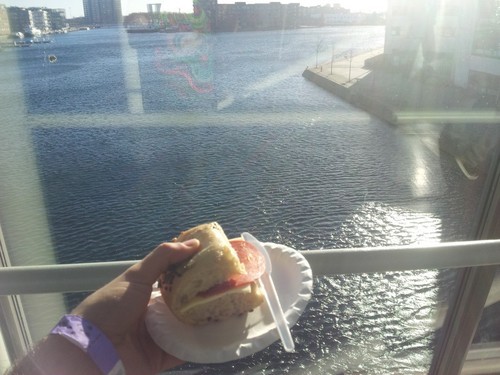
Read more about:
Featured BlogsYou May Also Like